Passive Instruments
LandTech is the only PST company which designs its own seismic equipment particularly adjusted to passive seismic tomography surveys (PST). The standard off-the-shelf seismographs, which are used by the Academic community and by some of our competitors, are not suitable for high resolution passive seismic tomography investigations due to their low sensitivity and low S/N ratio of the recorded seismic signals.
We possess the largest portable microearthquake network in the world. Since we manufacture our own equipment we can mobilize many hundreds of units worldwide and we can operate in parallel many passive networks in various countries. Furthermore in case of instrument malfunctions our engineers can repair them on-site using spare electronic boards.
LandTech has establish an affiliate company “Geobit” responsible for the design and manufacturing of all hardware used for our PST surveys.
Below we present some of our seismological instruments particularly designed for passive seismic. For an extended list of these equipment, description and technical characteristics please visit the site of our affiliate company www.geobit.gr
The LT SR-24 Digitizer
The SR-24 Digitizer has 3 input channels, and capability for connection to a wide range of sensors. The digitizer is based on a powerful, wide dynamic range delta-sigma analog-to-digital converter, with very low noise characteristics and excellent power supply rejection. The sampling rate can be set to 40, 50, 60, 100, 125, 150, 200, 250, 300, 400 and 500 samples per second.
Optional, sampling rates of 1, 2, 5, 10, 20, 25 and 600, 700, 750,1000 samples per second can be supported. Data are stored in a Compact Flash type storage unit. Maximum acceptable storage unit is 2 GB, enough to store approximately 26 days data of 3 channels @ 100 samples per second. Compact Flash card units larger than 2GB can be optionally used to increase the recording period.
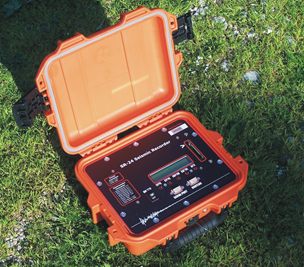
The power consumption is extremely low, allowing the recorder to operate connected to a typical 12V/55Ah battery without the need of recharging for long time periods. Communication plug-in allows the instrument to be connected to any Seiscomp PC. Seiscomp server collects data from the remote stations.The LCD display, displays the State-of-Health, time date and other information related to the instrument’s operation. Software tools have alse been developed to support both field and base station operation. The recorder is intended for installation in harsh environments and is supplied with a portable waterproof plastic case, manufactured of HPX high performance resin, with easy press & pull latches and durable soft-grip handle with easy access to all user features.
The LT S-100 Seismic sensor (seismometer)
The S-100 is a three-component velocity equivalent output seismic sensor. The design is based on the force-balance principle, thus using three simple geophone elements with natural frequency 4.5Hz the bandwidth of frequencies is extended from 90Hz, down to 0.2Hz.
The default length of the cable between the sensor and the electronics box is approximately 20 meters but it can be extended up to100 meters.
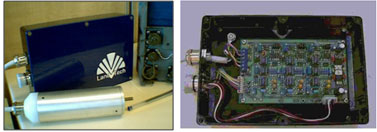
The geophones are housed in the same enclosure producing a solid waterproof sensor suitable for installation into boreholes where the noise is much less than the surface. The geophones are placed in order and are orientated following the 3-axes principle. A dot mark, incised on the plastic cover of the case, indicates the direction of each axis. Optionally, surface mount installation is available.
The sensor is totally controlled by an advanced signal conditioner circuit which supplies current to the geophones forcing them to a constant vibration at different frequencies. The signal conditioner circuit is fully protected against over voltage, opposite power supply polarity and lightning inductive currents. When inactive, it enters the "power-off" mode in order to reduce power consumption of the system.
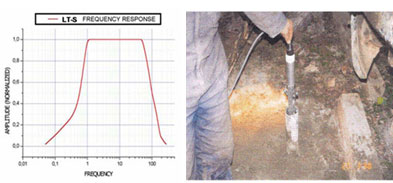
This (3-component) seismometer is specifically designed for passive seismic surveys with a flat response towards the higher frequencies (encountered in this kind of seismic data). It uses sensitive electromagnetic sensors and no phase distorting digital filtering and amplification modules (DSP's). The sensor is usually lowered to a depth of a few meters (in case of noisy areas) and is water proof.
The SeedlinkSR-24 low power 24bit real time telemetry station
LandTech has also developed a telemetry version of its SR24 digitizer. This unit is used in remote places where the accessibility is difficult. In this case data are sent to the collection centre via telemetry while the station is powered via solar panels. In addition to GSM telemetry the data can be sent via FM or Satellite telemetry as well.
The SeedlinkSR-24 seismic station consists of a combination between the SR-24, 3channels 24 bit digitizer, and an ARM embedded PC running Embedded Linux. The open source Seiscomp/Seedlink software has been compiled for the ARM-Linux operating system, and has been installed to the flash memory of the PC. The implication of the ARM based embedded PC enables the system to operate with considerably low energy consumption, running on a simple 12V55Ah DC battery for a long time. The SR-24 digitizer has 3 input channels, and capability for connection to a wide range of sensors. The digitizer is based on a powerful, wide dynamic range delta-sigma analog-to -digital converter, with very low noise characteristics and excellent power supply rejection. The sampling rate can be set to 1, 5, 25, 40, 50, 60, 100, 125, 200, 250, 300, 400 and 500 samples per second. The embedded PC provides an ethernet port. Configuration as well as communication with the unit is achieved through the ethernet port. Real time telemetry can be achieved by connecting the instrument with any communication device like GSM modem, satellite modem UHF wide spectrum modem, wireless ethernet bridges... and many more. The station communicates with any seedlink server implementing a reliable real time seismic station.
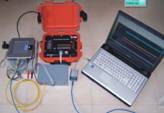

The LT FS ultra-sensitive sensor
The LandTech FS sensor is the only surface sensor in the market which can record microseismic events (even negative magnitudes!) from many Km down even microseisms generated during hydraulic fracking of a reservoir.
The sensor body has been designed in order to house twin or quad geophone strings for each axis. The orientation follows the 3-axis principle. This sensor has an external diameter of 50mm allowing it to be installed into small and shallow boreholes, hence reducing the cost of installation.
The sensor houses OMNI-2400 geophones. Using single geophone element per axis, the electronic noise floor becomes a limiting factor for this type of acquisition. Increasing the gain and minimizing the noise floor of the sensor give us the ability to record even smaller events.

Efforts were concentrated on minimizing the electronic noise floor, increasing the down hole gain, and increasing the sensor sensitivity. This target has been achieved by adding more geophones (1-4) to the down hole sensor connected in series. Four different sensor have been manufactured.
The signal conditioner circuit is fully protected against over voltage, opposite power supply polarity and lightning inductive currents. When inactive, it enters the "power-off" mode in order to reduce power consumption of the system.
The LT S110 ultra low power borehole accelerometer
The S-110 is a three-component acceleration equivalent output sensor. The design is based on the force-balance principle, thus using three simple geophone elements with natural frequency 4.5Hz the bandwidth of frequencies is extended from 90Hz, down to 0.2Hz. Sensitivity is adjusted to steps 1g, 0.5g, 0.2g, 0.1g.
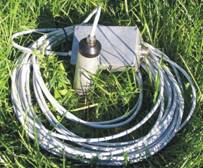
The sensor is totally controlled by an advanced signal conditioner circuit which supplies current to the geophones forcing them to a constant vibration at different frequencies. The signal conditioner circuit is fully protected against over voltage, opposite power supply polarity and lightning inductive currents. When inactive, it enters the "power-off" mode in order to reduce power consumption of the system.
The SM1500 & SM550 Strong Motion Sensors
| 3-axis accelerometers |
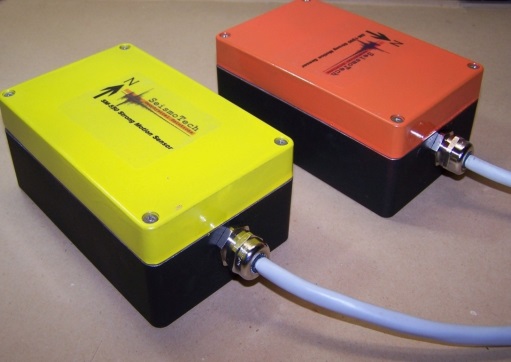 |
| Ultra Low Power Consumption |
| Surface mounting |
| MEMS technology |
| DC – 1500Hz BW |
| Wide Dynamic Range 117dB |
| Output range +/-3g linear |
| Noise level 0.3ugrms vHz |
| Operating temperature -20 to +70oC |
The OBS 24 offshore seismograph
The OBS 24 offshore seismograph, can record microseismic events occurring under oceanic sea bottom and below water depths up to 10Km. It uses atomic clock for accurate timing. The Instrument’s main structure is a glass sphere of 43 cm of diameter inside which all the electronic units and the submarine type battery packs are placed.

We have placed the 3-component seismometer outside the sphere held by a side arm that deploys the geophone once the OBS is on the sea bottom. In the tri-axial geophone case, magnetic accelerometers of type SM-6 I/O with a sensitivity of 28.8 V/m/s is used. Three perpendicular, one vertical and two horizontal sensors are placed inside a special housing to support the 600 atm. water pressure. The coupling of the overall geophone has been optimized in order to maximize sensitivity.
The sensor electronics are the same as those used in our LTS-100 wide band sensor, which is using the force-balance principle in order to extend the frequency bandwidth of the geophones, from 4.5Hz to a wide frequency band 0.2Hz to 98Hz. Sensitivity is high, increased to 1000V/m/sec. Using this technique, the OBS has a ideal sensor for local and regional seismicity monitoring. In additional, a hydrophone is used with a pre-amplifier of gain 4.
The recording unit is consists from three different stages. The input stage implements the force-balance circuitry, the 4-channels digitizer, which does the A/D conversion and the recorder, which stores the data into a removable Compact Flash type card (CF). The recording systems runs a proprietary embedded DOS-compatible file system, in order the recorded data be processed by any DOS or Linux compatible PC. The recording file system is FAT-32 compatible allowing the usage of large volume CF (64Gb). This size is able to store 4-channels data being sampled @ 250sps, for a period at least 4 months. The digitizer has very high dynamic range, greater than 135bB, allowing it to be able to record micro-events. Power consumption is very low.
Timing of the data is a very important issue, and has to be precisely done, even in the absence of GPS signal. In order to achieve high time accuracy, the DPLL unit of our SR-24 and CR-24 seismic instruments, have been redesigned in order to operate for long period, with minimum drift. Two version of the OBS-DPLL unit are available: One that user a extremely precise OCXO crystal oscillator, with accuracy +/-5ppb (5*10e-9 sec) and another version that uses Atomic Clock with 1,5*10e-10 sec precision.
The DPLL – RTC system uses a 12 channels GPS receiver in order to be synchronized while the OBS is still out of the water. Once is has been synchronized, the GPS is automatically switched off and the time synchronization of the digitizer is taken from the DPLL. After the end of the recording period, and when the OBS is out of the water, the GPS is switched on again, in order to allow the system to measure the overall drift of the acquisition period. Since this drift is linear, because the temperature at the sea bottom is very stable, the user is able to apply time correction to the recorder data, if necessary, using the appropriate software. Of course there is absolutely no need for any time correction when the DPLL is using the atomic clock as time reference.
The OBS is attached on an anchor weight that drives and places the instrument at the sea bottom. Between the OBS sphere and the metallic base, there is a mechanism, which is able to release the sphere from the metallic base, and let is free to come up because of the buoyancy. This mechanism, can be operate with two ways. The first one receives the release command from the surface using an ultrasonic frequency, and the second one uses a timer, which releases the instrument after some pre-defined period of time. For maximum safety, both mechanisms are used.
The precise positioning of the OBS on the sea bottom is done by acoustic triangulation which makes use of underwater acoustic signals. By interrogation a slant range distance between the OBS on the sea bottom and the shipboard acoustic transponder unit is measured with an accuracy of 1 m. By shifting the ship position at several sites and measuring each distance between the OBS and each ship sites, we can locate the OBS position within several meters. The positioning of the ship is made by a differential GPS method.
SR32 digitiser- “State of the Art” 32-bit resolution seismic digitizer
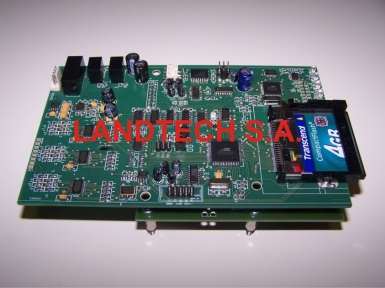
Landtech introduces the “state of the art” 32-bit resolution seismic digitizer, based on it’s latest technology. It has three analog channels, with extremely high resolution, especially in higher sampling rates from 250 to 1000 samples per second (sps). The effective resolution is 23.6 bits when the data rate is 250 sps, giving a dynamic range greater of 136db to the instrument. Power consumption is extremely low, only 0.7W, allowing it to operate for long period, powered from a small 7.2Ah Lead-Acid battery. CoRE32 format data files are recorded directly to FAT32 removable compact flash card. Timing is performed using a very accurate DPLL unit getting synchronized from a GPS receiver. The drift is extremely low (4*10-9sec) when GPS is off, and it can be periodically on and synchronize the DPLL. The digitizer provides also real time data streaming in parallel with the local (CF) data storage, trough the serial port, or Ethernet port, or wi-fi spot. The digitizer is ideal for micro-cracking monitoring, hydraulic fracking monitoring, micro-seismic monitoring and other applications that high resolution and high dynamic range is required.
 |
 |
| Raw Data Plot |
 |
 |
| Signal Spectrum |
Signal Histogram |
The CR24 Compact Seismic Digitizer / Recorder
| 24 bit compact digitizer / recorder |
 |
| Integrated sensor electronics |
| Low Power consumption |
| GPS / DPLL time accuracy |
| Sampling Rate 1 – 500sps |
| Continuous Recording Mode |
| Removable CF data storage |
| FAT16 or FAT32 filing system |
| Operating Temp -20 to +70oC |
The DR24 telemetry Digitizer / Recorder
| 24 bit digitizer / recorder |
 |
| Ultra Low Power consumption |
| GPS / DPLL time accuracy |
| Sampling Rate 1 – 500sps |
| 24days long data buffer |
| Removable CF data storage |
| SeedLINK plug-n-play telemetry |
| Operating Temp -20 to +70oC |
| LCD screen |
| Serial or Ethernet data & control port |
| Communication over GPRS, VSAT, DSL |
The SR32 Wireless Seismic Network
 |
| Wi-Fly technology – Real time data transmission |
| Station connections in chains – manual addressing mode |
| Ability for repeater usage if not clear line of sight |
| Error correction transmission algorithm |
| Satellite transmission of the network data in near real time |
SR32VHF technology – Real time P&S arrival times transmission
This the latest development of LandTech Enterprises in the field of real time reservoir monitoring. Instead of collecting all the waveforms from all deployed seismographs of the deployed surface network to a central processing unit, each 32 bit seismograph has an embedded PC with auto-picking algorithms and we send via VHF to the central processing unit only the arrival times of the seismic phases.

On Site Repair if necessary!!!
On site repair of our instruments using our large amount of spare boards since we manufacture them!!!


